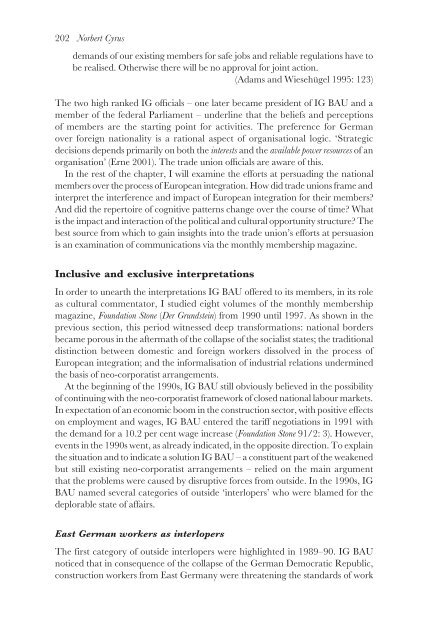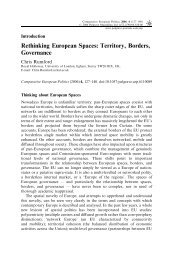Europeanisation, National Identities and Migration ... - europeanization
Europeanisation, National Identities and Migration ... - europeanization
Europeanisation, National Identities and Migration ... - europeanization
Create successful ePaper yourself
Turn your PDF publications into a flip-book with our unique Google optimized e-Paper software.
202 Norbert Cyrus<br />
dem<strong>and</strong>s of our existing members for safe jobs <strong>and</strong> reliable regulations have to<br />
be realised. Otherwise there will be no approval for joint action.<br />
(Adams <strong>and</strong> Wiesehügel 1995: 123)<br />
The two high ranked IG officials – one later became president of IG BAU <strong>and</strong> a<br />
member of the federal Parliament – underline that the beliefs <strong>and</strong> perceptions<br />
of members are the starting point for activities. The preference for German<br />
over foreign nationality is a rational aspect of organisational logic. ‘Strategic<br />
decisions depends primarily on both the interests <strong>and</strong> the available power resources of an<br />
organisation’ (Erne 2001). The trade union officials are aware of this.<br />
In the rest of the chapter, I will examine the efforts at persuading the national<br />
members over the process of European integration. How did trade unions frame <strong>and</strong><br />
interpret the interference <strong>and</strong> impact of European integration for their members?<br />
And did the repertoire of cognitive patterns change over the course of time? What<br />
is the impact <strong>and</strong> interaction of the political <strong>and</strong> cultural opportunity structure? The<br />
best source from which to gain insights into the trade union’s efforts at persuasion<br />
is an examination of communications via the monthly membership magazine.<br />
Inclusive <strong>and</strong> exclusive interpretations<br />
In order to unearth the interpretations IG BAU offered to its members, in its role<br />
as cultural commentator, I studied eight volumes of the monthly membership<br />
magazine, Foundation Stone (Der Grundstein) from 1990 until 1997. As shown in the<br />
previous section, this period witnessed deep transformations: national borders<br />
became porous in the aftermath of the collapse of the socialist states; the traditional<br />
distinction between domestic <strong>and</strong> foreign workers dissolved in the process of<br />
European integration; <strong>and</strong> the informalisation of industrial relations undermined<br />
the basis of neo-corporatist arrangements.<br />
At the beginning of the 1990s, IG BAU still obviously believed in the possibility<br />
of continuing with the neo-corporatist framework of closed national labour markets.<br />
In expectation of an economic boom in the construction sector, with positive effects<br />
on employment <strong>and</strong> wages, IG BAU entered the tariff negotiations in 1991 with<br />
the dem<strong>and</strong> for a 10.2 per cent wage increase (Foundation Stone 91/2: 3). However,<br />
events in the 1990s went, as already indicated, in the opposite direction. To explain<br />
the situation <strong>and</strong> to indicate a solution IG BAU – a constituent part of the weakened<br />
but still existing neo-corporatist arrangements – relied on the main argument<br />
that the problems were caused by disruptive forces from outside. In the 1990s, IG<br />
BAU named several categories of outside ‘interlopers’ who were blamed for the<br />
deplorable state of affairs.<br />
East German workers as interlopers<br />
The first category of outside interlopers were highlighted in 1989–90. IG BAU<br />
noticed that in consequence of the collapse of the German Democratic Republic,<br />
construction workers from East Germany were threatening the st<strong>and</strong>ards of work



